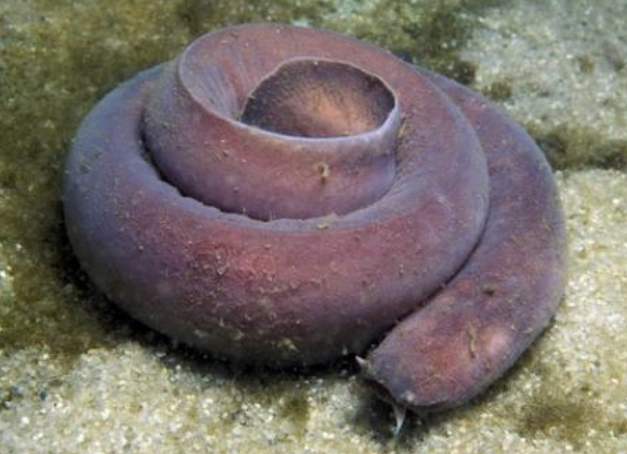Slimy Facts About Hagfish
Slimy Facts About Hagfish
1. Hagfishes, along with Lampreys are two of the four surviving classes of “fish”, the other two classes being sharks and bony fish . Both the hagfish and lamprey classes contain few living species, and the two groups are the most primitive extant vertebrates, with definite fossil records of lampreys dating back at least 280 million years, and hagfishes dating back 350 million years.2. Hagfishes have a cartilaginous skeleton; a scale-less, eel-like body; a jawless mouth, and no paired fins or dorsal fin. Hagfish have an inefficient, paddle-like tail; degenerate eyes (which are completely covered by skin and a vestigial third eye), and a single, prominent nostril. The laterally-biting mouth of hagfish has barbels, and there are teeth on the tongue and one on the “palate”.
3. Hagfish have mucus pores in 2 lateral lines, each line with about 70-200 glands containing mucus cells and thread cells . Hagfish have the ability to exude large volumes of mucus from the glands, as a defensive mechanism
4. Hagfish are used as food in Japan and South Korea, and their hides are processed into 'eel' leather in Korea.
6. Members of the class Myxini have a partial cranium (skull), but no vertebrae. Their skeleton is made of cartilage, as is that of sharks. Hagfish lack jaws, and for this reason used to be classified with the lampreys in a group called the Agnatha ("no jaws") or the Cyclostomata ("round mouth").
7. Dubbed the most disgusting of all sea creatures.
8. A hermaphrodite, which lays numerous, large eggs in a hard case. It is unlikely that these fish are self-fertilizing hermaphrodites and need a partner to breed.
9. Hagfish are found in all depth of water and lie buried in fine sands or silt when not feeding.
10. They feed on most fish, living or dead. Hagfish are the first fish to find their way to any dead animals which find their way to the seabed.
11. They are parasitic on live fish, attaching themselves to the side and slowly eating their way through the fish. It has been known to find Cod with as many as 30 young Hagfish attached to them.
12. Hagfish belong to the group of primitive, jawless fish which includes the marine and freshwater lampreys. They are considered a threat to commercial fish stocks of the North Sea because if the fish are not killed outright by the attacks, they usually succumb to later infections caused by the large wounds left by the Hagfish.
13. An unmistakable eel-like body that is uniformly pink in color. The mouth is a slit surrounded by fringe of short, fleshy barbels. A fleshy fin runs from the vent to the rear portion of the back, and a row pores runs along both sides from the head to the tail. A thick layer of glutinous slime (hence specific name) covers the whole body and can be sloughed in copious amounts when handled
14. Hagfish have a row of ducts located ventrally along the body for the exit of mucous from the numerous slime glands
15. Its body fluid are in osmotic equilibrium with sea water. This makes it easier to maintain water balance and deal with some waste.
16. Can tie itself in a knot to more securely attach itself to its prey.
17. Can generate enormous amounts of slime.



Comments
Post a Comment